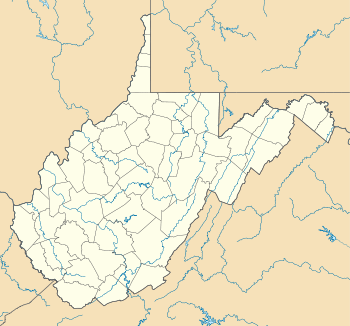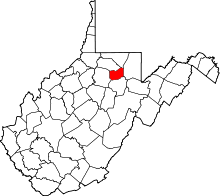Fetterman, West Virginia
| Fetterman | |
|---|---|
| Unincorporated community | |
 Fetterman  Fetterman Location within the state of West Virginia | |
| Coordinates: 39°20′58″N 80°2′17″W / 39.34944°N 80.03806°WCoordinates: 39°20′58″N 80°2′17″W / 39.34944°N 80.03806°W | |
| Country | United States |
| State | West Virginia |
| County | Taylor |
| Elevation | 1,024 ft (312 m) |
| Time zone | Eastern (EST) (UTC-5) |
| • Summer (DST) | EDT (UTC-4) |
| GNIS ID | 1538943[1] |
Fetterman is an unincorporated community or populated place located in Taylor County, West Virginia. The elevation is 1,024 feet (312 m). Fetterman appears on the Grafton U.S. Geological Survey Map. Taylor County is in the Eastern time zone (GMT -5) and in postal zip code 26354. Fetterman was one of the early settlements in what became Taylor County, Virginia, (later West Virginia). It was located at the crossing of the Tygart Valley River by the Northwestern Turnpike.
History
Fetterman was founded in 1854.[2] The community was named for a resident of Pittsburgh who owned the town site.[3]
American Civil War
In the early days of the American Civil War, before Virginia had completed the process of secession from the Union, Virginia formed a state army and navy under the command of Virginia Major General Robert E. Lee. Lee sent Colonel George A. Porterfield to Grafton, Virginia to organize and recruit new members for the secessionist forces for the state, with a view toward joining the Confederacy, to hold northwestern Virginia for Virginia and ultimately the Confederacy. Porterfield also was ordered to hold and protect the Baltimore and Ohio Railroad, but to destroy bridges to impede Union forces if it could not be held. Porterfield found that sympathies at Grafton were largely with the Union and the Grafton Guards under Captain George R. Latham were organized at Grafton. Porterfield moved to nearby Fetterman and began to gather a company from the area, the Letcher Guard or Letcher's Guard, and companies that supported the Confederacy from other locations in the region. Porterfield's men briefly held Grafton when the Grafton Guards went to Wheeling, Virginia to be mustered into the Union Army on May 25, 1861.
A few days later, Porterfield learned that larger Union forces were moving toward Grafton and he withdrew to Philippi in Barbour County, about 30 miles (48 km) to the south of Grafton. At about dawn on June 3, 1861, the larger Union force surprised the Confederates under Porterfield's command who were mostly still asleep in their tents and routed them, although with only a few men wounded on both sides and about five prisoners taken by the Union force, in the Battle of Philippi, soon called the Philippi Races due to the hasty retreat of the Confederate force.[4][5][6]
Thornsbury Bailey Brown of Taylor County, Virginia (now West Virginia) is generally considered the first Union soldier killed by a Confederate soldier during the American Civil War. Brown was a member of a Virginia militia company, the Grafton Guards, which supported the Union. He was killed by a member of a Virginia militia company which supported the Confederacy from the same general vicinity, the Letcher Guard, at the bridge at the intersection of the Northwestern Turnpike and the Baltimore and Ohio Railroad at Fetterman, Virginia (now West Virginia) on May 22, 1861.
Later inclusion with Grafton
Fetterman has been absorbed by the expansion of Grafton, West Virginia and is considered a populated location within the incorporated place of Grafton. Grafton is an incorporated place located in Taylor County, West Virginia at latitude 39.341 and longitude -80.019.
Notes
- ↑ U.S. Geological Survey Geographic Names Information System: Fetterman, West Virginia
- ↑ Kenny, Hamill (1945). West Virginia Place Names: Their Origin and Meaning, Including the Nomenclature of the Streams and Mountains. Piedmont, WV: The Place Name Press. p. 240.
- ↑ Gannett, Henry (1905). The Origin of Certain Place Names in the United States. Govt. Print. Off. p. 125.
- ↑ Atkinson, George Wesley and Alvaro Franklin Gibbens. Prominent Men of West Virginia: Biographical Sketches, the Growth and Advancement of the State. Wheeling, WV: W. L. Callin, 1890. OCLC 58869666. Retrieved May 4, 2011. p. 485
- ↑ Lang, Theodore F. Loyal West Virginia from 1861 to 1865. Baltimore: The Deutsch Publishing Company, 1895. OCLC 779093. Retrieved May 4, 2011.
- ↑ Hall, Granville Davisson. Lee's Invasion of Northwest Virginia in 1861. Chicago: Press of the Mayer & Miller Co., 1911. OCLC 5660822. Retrieved May 4, 2011.
References
- Atkinson, George Wesley and Alvaro Franklin Gibbens. Prominent Men of West Virginia: Biographical Sketches, the Growth and Advancement of the State. Wheeling, WV: W. L. Callin, 1890. OCLC 58869666. Retrieved May 4, 2011.
- Source: U.S. Census Bureau: State and County QuickFacts.
- Hall, Granville Davisson. Lee's Invasion of Northwest Virginia in 1861. Chicago: Press of the Mayer & Miller Co., 1911. OCLC 5660822. Retrieved May 4, 2011.
- Lang, Theodore F. Loyal West Virginia from 1861 to 1865. Baltimore: The Deutsch Publishing Company, 1895. OCLC 779093. Retrieved May 4, 2011.
